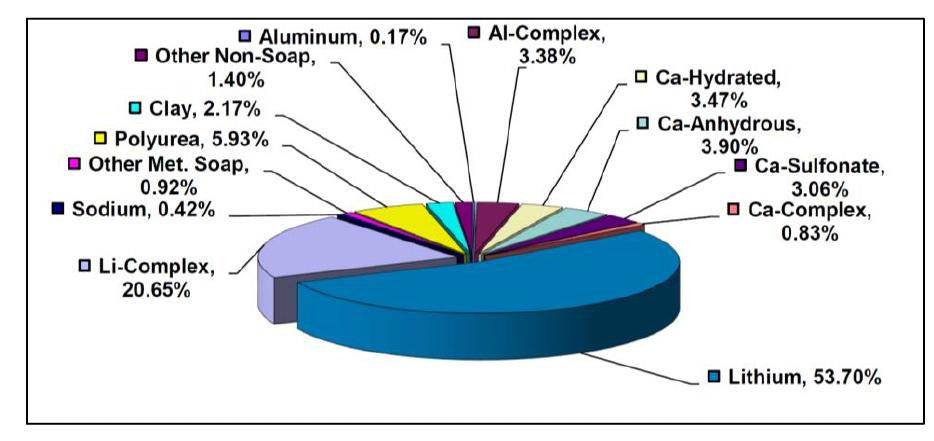
18 minute read
Performance Considerations in Formulating Multi-Purpose EP Greases
Vasu Bala and Jim Hunt Tiarco Chemical, Dalton, GA USA
Abstract
This paper discusses three studies of effects of additives on performance properties of greases. Three base greases were studied: two lithium complex thickeners and one calcium sulfonate thickener. The additives were conventional EP (extreme pressure), anti-wear and corrosion inhibitor additives. Greases were tested for effects of individual additives and combinations of additives on weld loads in four-ball EP tests, wear scar diameters in four-ball wear tests and performance in copper corrosion tests. This paper shows that it is possible to use additives to optimize and balance these performance properties.
This study was motivated by performance trends for EP greases and formulation considerations to meet and balance performance requirements for load bearing, wear and yellow metal corrosion. This paper includes background information that highlights important formulation considerations such as current sourcing demands for key raw materials used in thickeners. Additional formulation considerations include Original Equipment Manufacturers’ (OEM) requirements, current global supply chains, and possible changes that may be required to provide alternate greases and support new approvals. Supplies of key raw materials and anticipated future OEM requirements are driving the development of new grease formulations and encouraging manufacturers to consider alternate chemistries to ensure long-term sustainability of greases for industrial and automotive markets.
Outline I. II. III.
IV.
V. Introduction Grease Market Breakdown, Drivers and Trends Grease Classifications and Specifications A. General Grease Properties B. ASTM D4950 Standard Classification and Specification for Automotive Service Greases C. SAE J310 D. ISO Standards E. DIN 51825 F. JIS K2220 Studies of Grease Additives and Interactions A. Grease Formulation B. Properties of Greases and Additives Used in This Study C. Study 1: Effects of EP and Corrosion Inhibitor Additives in Lithium Complex Grease D. Study 2: Effects of EP, Corrosion Inhibitor and Anti-Wear Additives in Calcium Sulfonate
Grease E. Study 3: Effects of EP and Corrosion Inhibitor Additives in Lithium Complex Grease Conclusions Acknowledgements References
I. Introduction
OEMs are continuously striving to improve energy efficiency of machines by designing gear boxes with higher power densities and sumps with smaller capacities. End users are operating machines at slower speeds to reduce churning and traction losses, using lower grease and lubricant levels and opting for longer drain intervals. These drivers are placing higher performance demands on greases and other lubricants. New products must inherently be able to provide lubrication under higher loads and lower speeds, possess improved thermal and oxidative stability, and operate in wider temperature ranges and harsher environments.
In meeting these higher performance trends with multipurpose EP greases, careful consideration is needed with respect to the type and functionality of key EP, anti-wear and corrosion inhibitor additives used to formulate these products. Typical additives used for load bearing are metal dithiocarbamates, sulfurised olefins, polysulfides, sulfurised esters and metal sulfides, for example, molybdenum disulfide. In recent years, ashless multifunctional additives such as thiadiazoles and alkyl dithiocarbamates have gained popularity. These additives collectively can achieve higher load bearing performance, but typically at the expense of less effective resistance to wear and corrosion.
This paper discusses test results for grease formulation options with select additives to attain high load bearing performance while improving anti-wear and corrosion performance.
II. Grease Market Breakdown, Drivers and Trends
The National Lubricating Grease Institute’s (NLGI) most recent survey (in 2018) reported fairly stable production for 2017 at 2,587 million pounds of grease. Their global survey included 226 companies and 261 grease plants. The largest growth was noted for Europe and North America at 8.3 and 2.4%, respectively.
Production of lithium complex grease increased by 2.3% (at the expense of standard simple lithium grease), and production of polyurea grease grew to 6% of total grease production (Figure 1). The largest growth was seen in calcium sulfonate greases by 12%. Another leading trend was the increasing use of synthetic and non-conventional base oils, with Europe leading in their use (Figure 2).
Figure 1. 2017 Grease Production from 2018 NLGI’s Survey (1)
Figure 2. Base Oils used in Grease Production for 2016 & 2017 (1,2)

Demands from government regulations and OEMs are leading to the development of greases that are environmentally safe and targeted for extended service. Environmental factors are reduced water hazard classification, no heavy metals, no chlorinated compounds and increasing degree of biodegradability. OEMs are developing smaller components, bearings and constant velocity joints (CVJs) in cars. As well, OEMs are improving automobile reliability and less re-greasing (or more extended life), which places increasing performance demands on greases and brings about changes in the type of chemistries used in greases. Selection of soap and thickener types, base oil types and viscosities and improved thermal stability, washouts and bleed rates are key parameters for consideration. The performance additives used in greases need to be re-evaluated for their type and function to enhance the overall performance of greases, which is the purpose of this study.
III. Grease Classifications and Specifications A. General Grease Properties
Lubricating greases are made of a thickening agent such as metallic soap, urea, carbon black or clay, and a base blend of synthetic and/or mineral base oils, rheology modifiers, tackifiers and performance additives. This unique composition allows greases to be used in applications where the lubricant must stay in position. Greases also assist in prevention of contaminants from entering critical mechanisms such as bearings, CVJs and gear boxes.
There are various typical tests that quantify the properties of greases.
The viscosity of a grease is dependent on the shear rate. Due to its thickening constituents, the grease acts as a solid or semi-solid at low shear rates. As the shear rate increases, the viscosity of the grease decreases to the limit of the base blend viscosity. This apparent viscosity is affected by the type and amount of thickener and cannot be lower than the base blend’s viscosity. This property is important for determining the flow of grease through dispensing lines and can be measured by ASTM D1092. Another key property of the grease is its consistency, which is measured by the depth to which a cone will penetrate into a prescribed sample of grease. NLGI has designated the numerical grade for grease consistency depending on the depth of penetration as described in ASTM D217. Table 1 shows the Consistency Numbers as defined by NLGI.
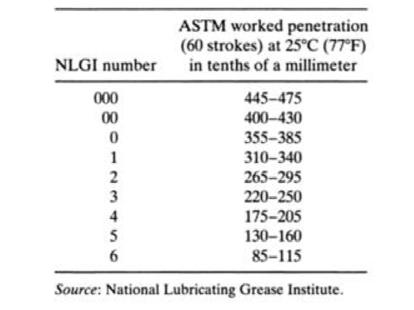
Elastomer compatibility of greases is important to ensure that seals maintain their sealing ability. Any grease leakage (or contamination of grease) can lead to premature failure. ASTM D4289 measures the hardness and volume changes after elastomer samples are immersed in the grease for a specified temperature and duration.
The temperature at which the grease becomes a liquid is called its dropping or drop point. This is measured by ASTM D566 and subjects the grease to temperatures as high as 260 C. For higher dropping points, ASTM D2265 is used for temperatures up to 330 C. ASTM D972 and ASTM D2595 can be used to measure evaporative weight loss up to 316 C.
Other key functional tests include:
Corrosion resistance as measured by ASTM D1743. Measurement of the effective lubrication of bearings by greases by ASTM D1263, ASTM D 1264, ASTM D1741, ASTM D3527 and ASTM D4290. The mechanical stability of a grease can be determined by measuring the change in consistency after working or shearing for two hours at room temperature as described by ASTM D1831. Another key test for greases is the measurement of the oxidative stability by ASTM D942, but the results have limited correlation to predict field performance. Other oxidation tests available for consideration are the Penn State Micro-Oxidation test and Pressure Differential Scanning Calorimetry (PDSC) test in ASTM D5483. Measurement of oil separation in grease during stoarge is described by ASTM D1742. This method is a static test and does not simulate oil separation during dynamic applications. Measurement of fretting wear of ball bearings under a prescribed oscillation and load is described by ASTM D4170. Fretting wear can occur for bearings installed in machinery during shipment.
Table 2 provides a summary list of key ASTM test methods for qualifying greases.
Table 2. List of Common Key Grease Property Tests
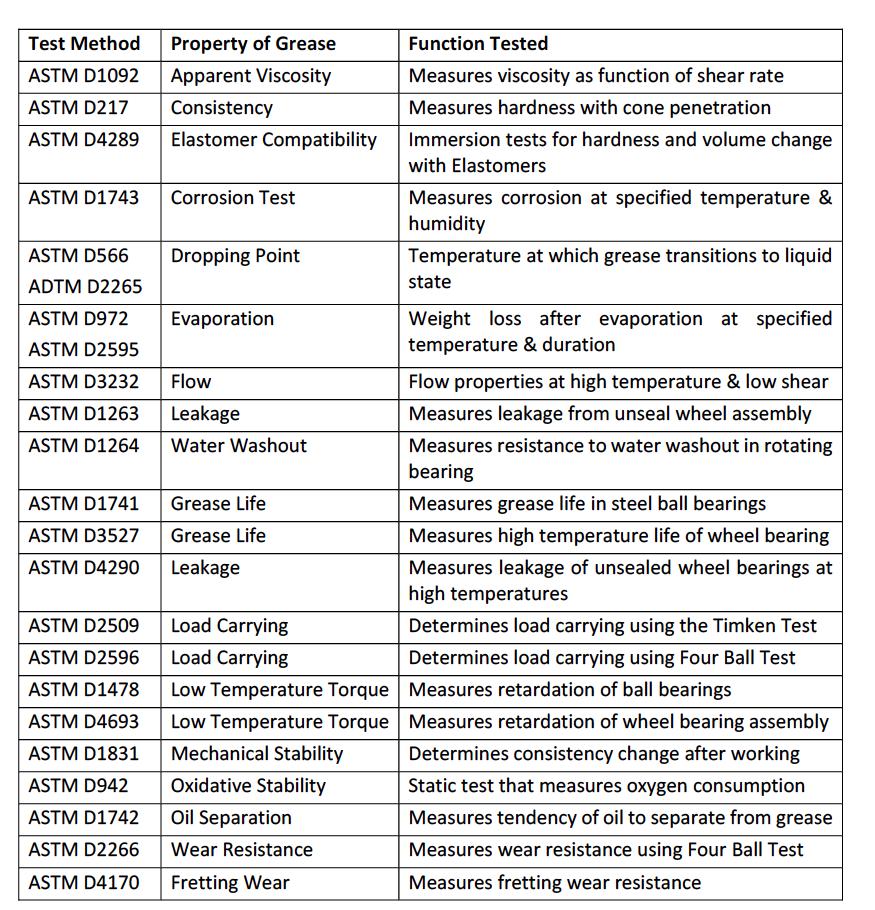
B. ASTM D4950 Standard Classification and Specification for Automotive Service Greases (3,4)
The collaboration between American Society for Testing and Materials (ASTM), Society of Automotive Engineers (SAE) and NLGI led to the development and release of ASTM D4950 Standard Classification and Specification for Automotive Service Grease in 1989. This standard was collectively accepted by OEMs for automotive applications. The early success of this standard (with the grease tests listed above) was made possible by the development of grease test methods for automotive applications. Specific key tests for automotive applications include:
• • • •
ASTM D3527 – Test Method for Life Performance of Automotive Wheel Bearing Grease
ASTM D4170 – Test Method for Fretting Wear Protection by Lubricating Grease
ASTM D4289 – Test Method for Compatibility of Lubricating Grease with Elastomers
ASTM D4290 – Test Method for Determining the Leakage Tendencies of Automotive Wheel
Bearing Under Accelerated Conditions
ASTM D4693 – Test Method for Low Temperature Torque of Grease Lubricated Wheel Bearing
ASTM D4950 classifies automotive service greases into chassis and wheel bearing categories. These two categories were further classified depending on the severity of the application, with two and three subcategories for chassis and wheel bearing greases, respectively. Table 3 describes the performance requirements for the chassis (LA, LB) and wheel bearing (GA, GB, GC) grease categories.
Table 3. Guide to Requirements for ASTM D4950 Grease Categories (4)
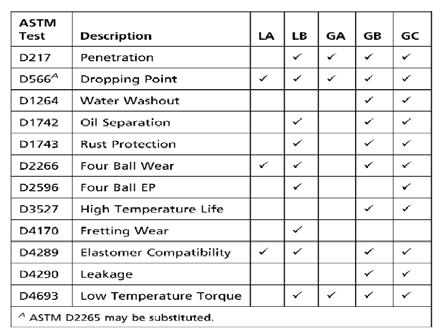
NLGI instituted a licensing procedure for greases qualifying for ASTM D4950 (3). This procedure applies to only to the highest performance level categories for wheel bearing grease (GC) and for chassis grease (LB). NLGI allows the use of three compliance symbols that can be applied to packaging and product literature. The greases having these symbols must be registered with NLGI and meet requirements for one or both of the highest-level categories (Fig. 3). NLGI does not offer symbols for the lesser performance categories, and NLGI specifically prohibits the creation and use of such symbols.
Industry acceptance of the licensing system has grown, and now the NLGI compliance symbols are commonly seen on product packaging and literature. Presently, most U.S. automakers recommend the use of NLGI Service Greases GC, LB and GC-LB for scheduled maintenance of chassis and wheel bearings of passenger cars and light-duty trucks (4).

Figure 3. NLGI Service Grease Illustrations (3)
C. SAE J310
This SAE Recommended Practice was developed by SAE. The section “Standard Classification and Specification for Service Greases” was developed by SAE in cooperation with ASTM and NLGI. It is intended to assist those concerned with the design of automotive components and with the selection and marketing of greases for the lubrication of certain of those components on passenger cars, trucks and buses. SAE J310 provides end users with an understanding of the terms related to properties, designations and service applications of automotive greases.
Table 4. Relative Importance of Lubricating Grease Properties for Automotive Use (5)
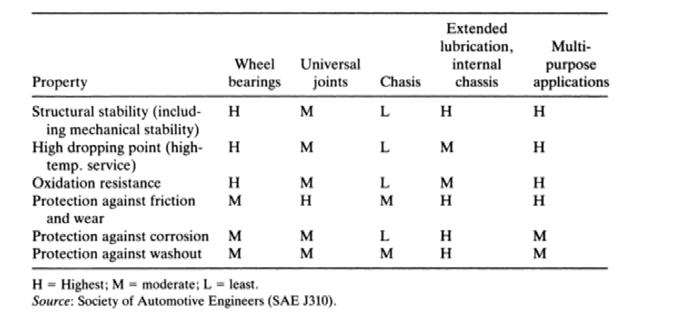
D. ISO Standards
ISO 6743 established a general system of classification for lubricants, industrial oils and related products. Within this classification, greases are also categorized (ISO 6743-9). It is stipulated that a product cannot have more than one symbol. For a product, the symbol corresponds to the most severe conditions of temperature, water contamination and load.
ISO 12924 specifies the requirements of greases used for the lubrication of equipment, components of machinery and vehicles. This standard provides guidance to suppliers, end users and OEMs and helps them take into consideration climatic conditions worldwide and requirements for greases at time of delivery. ISO 12924 is intended to complement ISO 6743-9.
E. DIN 51825
This German standard allows for the classification of industrial greases. The most common are as follows:
DIN 51825 K – grease made from high viscosity mineral and/or synthetic oil with a thickener. DIN 51825 KP-K – K grease made with additional additives that reduce friction and protect against wear in mixed friction locations. DIN 51825 KF – K grease with additional hard additives such as graphite or molybdenum disulfide. DIN 51825 KPF – K grease with additional additives that reduce friction and protect against wear in mixed friction locations, plus additional solid additives (graphite, molybdenum disulfide).
F. JIS K2220
This Japanese standard specifies lubricating greases and gear compounds to be used mainly as lubricants for various types of machine parts. There are several test methods and ISO standards that are cited. Key tests are ISO 2137 – Determination of Cone Penetration of Lubricating Greases and Petroleum; ISO 2176 – Determination of Dropping Point; ISO 11009 – Determination of Water Washout Characteristics of Lubricating Grease; ISO 12924 and ISO 6743-9.
IV. Study of Grease Additives and Interactions
The purpose of this study is to re-evaluate additives currently used in greases and asses their type, function and ability to enhance the overall performance of greases to meet new trends and requirements (discussed above).
A. Grease Formulation
The typical composition of grease includes up to 15% of performance additives, up to 20% of soap or other thickener and the remainder of up to 95% base oil (6). The performance additives include EP, anti-wear, corrosion inhibitors, metal deactivators, antioxidants and polymers for enhanced grease structure.
Some common examples of EP additives are metal-based dithiocarbamates, sulfurized olefins, alkyl polysulfides, zinc dialkyldithiophosphates and molybdenum disulfide, a solid. Typical anti-wear additives are zinc dialkyldithiophosphates and alkyl phosphates. Corrosion inhibitors and metal deactivators are amine phosphate salts, imidazoline derivatives and triazoles, respectively. Common antioxidants used are radical scavengers and peroxide decomposes. Table 5 provides the key additive types and their function in greases.
Table 5. Common Performance Additives and their Function in Greases

B. Properties of Greases and Additives Used in This Study
There were two grease types that were used in this study. Two were lithium complex greases (BG1 and BG3), and one was a calcium sulfonate grease (BG2). Base greases were compounded with their respective soaps, thickeners and base oils but no performance additives. Lithium complex base greases BG1 and BG3 were formulated with different base oils, thickeners and processing. All three greases had NLGI Grade 2 consistency. Then, different types and concentrations of additives were added to base greases, and their functional performance was compared. Interactions among the additives were quantified in several key performance tests. (Table 6)
Table 6. Base Greases and Performance Additives Used in This Study
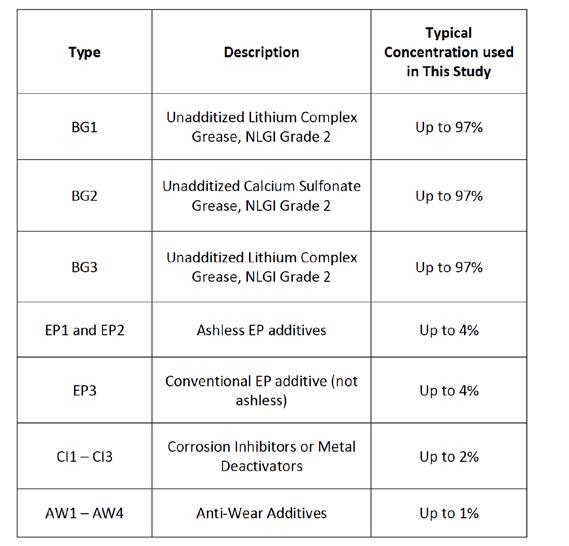
Blends were prepared from base greases BG1, BG2 and BG3 and various levels of the performance additives EP1-EP3, CI1-CI3 and AW1-AW4, and then tested using the following:
ASTM D2596 - Standard Test Method for Measurement of Extreme-Pressure Properties of Lubricating Grease (Four-Ball EP Method) ASTM D2266 – Standard Test Method for Wear Preventive Characteristics of Lubricating Grease (Four-Ball Wear Method) ASTM D4048 – Standard Test Method for Detection of Copper Corrosion from Lubricating Grease.
C. Study 1: Effects of EP and Corrosion Inhibitor Additives in Lithium Complex Grease
In the first study, EP1 and EP2 were blended with corrosion inhibitors CI1 and CI2 in base grease BG1. Figure 4 summarizes the weld load results from ASTM D2596. The base grease had a weld load of 400 kgf. The EP additives EP1 and EP2 improved weld substantially to 800 kgf.
The effect of EP1 was stronger than EP2 on copper corrosion performance (see Fig. 5). EP2 affected no change in copper corrosion when compared to the base grease. This result is atypical for EP additives.
Subsequent tests were then performed using EP2 in combination with CI1 and CI2. The corrosion inhibitor CI1 had negative effects on both weld load and copper corrosion. The weld load and copper corrosion results were not affected by the addition of CI2.
Figure 6 summarizes the wear scars from ASTM D2266. The addition of EP1 and EP2 in combination with CI1 and CI2 all marginally increased the wear scars. This suggests that the optimization of weld and corrosion inhibition affect wear performance. The effects of anti-wear additives in another study are discussed below.
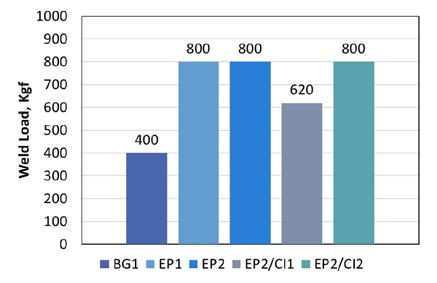
Figure 4. Effect of EP & CI Additives on Weld Loads in Lithium Complex Grease BG1
Figure 5. Effects of EP & CI Additives on Copper Corrosion in Lithium Complex Grease BG1
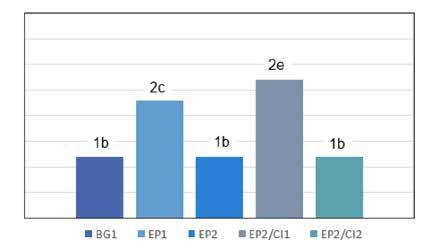
Figure 6. Effects of EP & CI Additives on Wear Scar in Lithium Complex Grease BG1

D. Study 2: Effects of EP, Corrosion Inhibitors and Anti-Wear Additives in Calcium Sulfonate Base Grease
In the second study, additives were blended in calcium sulfonate grease BG2 and evaluated for weld load, copper corrosion and wear scar diameter.
First, EP2 and CI2 were compared at different levels. Low levels of EP2 and CI2 did not change the weld load, which was the same as the base grease, 620 kgf (Fig. 7). But increasing the level of EP2 increased the weld load to 800 kgf. The result (800 kgf) was the same when the level of CI2 was also increased.
The wear scar diameter was 0.57 mm far the base grease, slightly smaller (0.52 mm) with low levels of EP2 and CI2, and slightly larger (0.61 mm) with a higher level of EP2 (Fig. 8).
The effect of CI2 on weld and wear was minimal. This suggests that the choice of EP additive can be critical for initial weld and wear performance. The copper corrosion results were 1a for the base grease and 1b with the various levels of EP2 and CI2 (Fig. 9).
Next, anti-wear additives were added as top-treats to grease that contained EP2 and CI2. With AW1, AW2 and AW4, the weld load was the same as the base grease (620 kgf). But with AW3, the weld load was 800 kgf.
The wear scar result was smallest (0.48 mm) with A3 (plus EP2 and CI2), Fig. 8. These results showed that the choice of AW can improve wear scar diameter while maintaining high weld load.
The copper corrosion results were all rated 1b. These results collectively show that it is possible to optimize performance for weld loads, wear scar and copper corrosion with the proper choice of EP, AW and CI additives.
Figure 7. Effect of EP, CI and AW Additives on Weld Loads in Calcium Sulfonate Grease BG2.
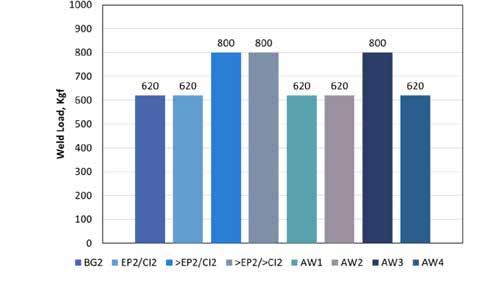
Figure 8. Effect of EP, CI and AW Additives on Wear Scars in Calcium Sulfonate Grease BG2.
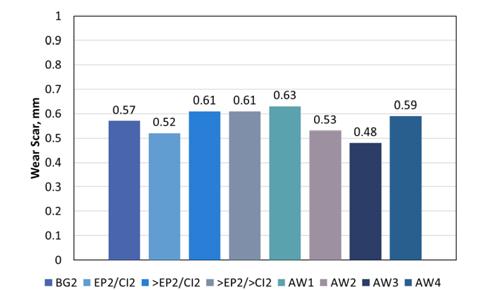
Figure 9. Effect of EP, CI and AW Additives on Copper Corrosion in Calcium Sulfonate Grease BG2.
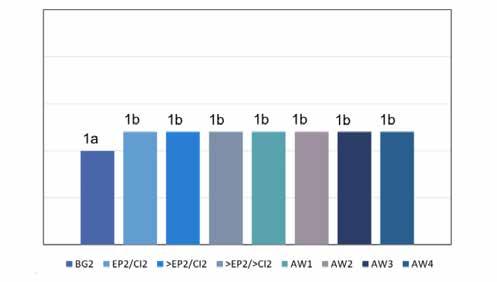
E. Study 3: Effects of EP and Corrosion Inhibitor Additives in Lithium Complex Grease.
In the third study, the effects of EP2 and EP3 and combinations with CI3 were evaluated for weld load and wear scar. Regression analysis was used to relate the data for weld loads and wear scars to the levels of additives tested. The weld loads were affected by combinations of EP2 and EP3 (see Fig. 10).
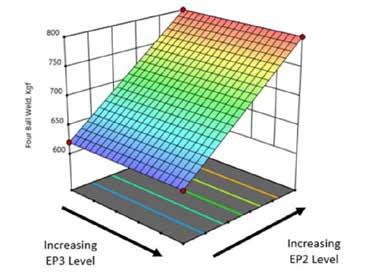
Figure 10. Effect of EP Additives on Weld Loads in Lithium Complex Grease BG 3
Either EP2 or EP3 can be used to target a wide range of weld loads. The interaction with the level of CI3 did not affect the weld loads.
Figure 11 plots the wear scar diameter versus levels of EP2 and EP3 at low (left) and high (right) levels of the corrosion inhibitor CI3. The data suggest that the wear scars are affected by the level of CI3. With a low level of CI2, the wear scar diameter decreased when the level of EP3 was increased but the level of EP2 was decreased. At the higher level of CI2, the wear scars were smaller when levels of both EP2 and EP3 were decreased.
The copper corrosion results for these combinations did not change the ratings from the base grease BG3, which was 2c. This study shows that a wide range of weld loads and wear scar diameters can be affected based on the choice of EP and CI additives.
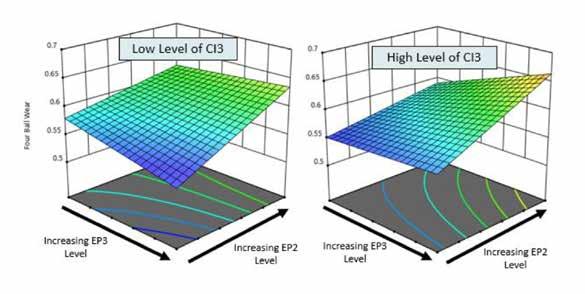
V. Conclusions
In summary, three studies were conducted with lithium complex and calcium sulfonate greases. Base greases were tested for weld load, wear scar and copper corrosion. Then EP, AW and CI additives were blended into each base grease, and the same tests were used to evaluate their effects.
The initial selection of EP, AW and CI additives is critical and does rely on the base grease used. The results from these studies show that it is possible to target high weld loads and mitigate wear scars while maintaining good copper corrosion prevention. The studies also show that synergies can be exploited between EP, AW and CI additives.
While optimization of a grease formulation with EP, AW and CI performance additives can be done, it is also necessary to confirm additional grease performance traits such as consistency, oxidation stability, oil separation and water washout. These performance parameters, although not discussed in this paper, are still important to evaluate overall performance of the finished grease.
Acknowledgements
The authors of this paper would like to express their gratitude and thanks to NLGI for the opportunity to present this work. They also would like to thank Tiarco Chemical for permission to publish and share the result of these studies of performance additives. Special thanks also go to Thomas Owens and Steve Sibo of the Grease and Lubricants Testing Laboratories at Tiarco Chemical for their assistance.
References
2018 NLGI Global Production Survey. 2017 NLGI Global Production Survey. NLGI Lubricating Grease Guide, 2015, Sixth Edition. Fuels and Lubricants Handbook: Technologies, Properties, Performance and Testing, G. E. Totten, S. R. Westbrook, R. Shah, 2003, pg. 557 – 572. Shaft Seals for Dynamic Applications, L. Horve, CRC Press, 1996, pg. 82 – 88. Basic Grease Education Course, STLE, May 2017.






